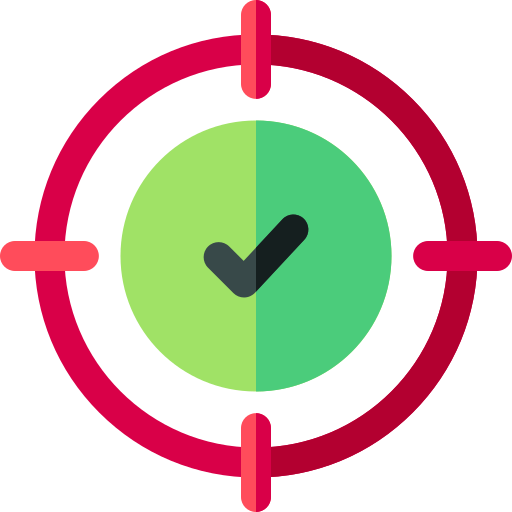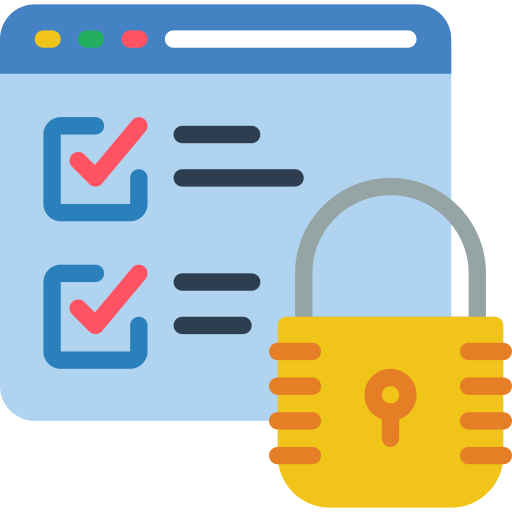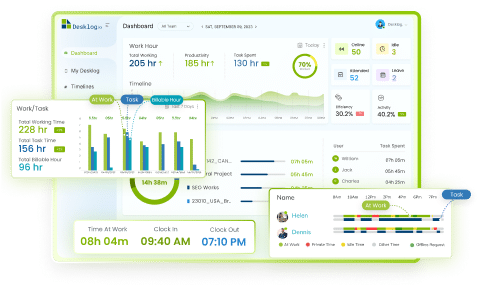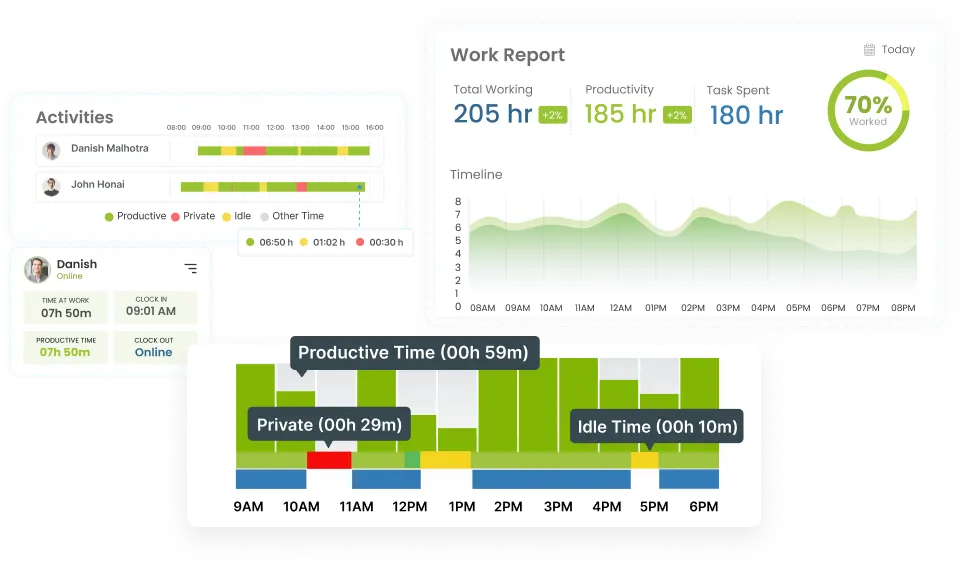How to Explain the Need of Time Tracking to Your Employees
In this productivity reigning world, there’s a superhero that often goes unnoticed but wields incredible power – Time Tracking. Yes, you heard it right – tracking time isn’t just about punching in and out of work; it’s a strategic tool that can transform your organization’s efficiency and profitability. Companies everywhere are realizing this and deploying time tracking software among their employees to manage their workforce.
Yet, convincing your employees of the need for time tracking can sometimes feel like a Herculean task. They seem to have their fair share of concerns over being monitored. But it is the duty of managers to ease the team into using time tracking by explaining the benefits and addressing all their concerns.
Here we will have a look at how to explain time tracking to your employees. In this blog, we’ll unravel the mysteries surrounding the ‘Need of Time Tracking,’ and equip you with the insights and strategies to not only explain its significance to your workforce but also inspire them to embrace it as a valuable ally in their daily tasks.
Most Common Concerns About Time Tracking at Work

Privacy Concerns
Employees may worry that time tracking systems invade their privacy. They may be concerned that their every move is being monitored, leading to a sense of surveillance or distrust.

Micromanagement
Employees feel that time tracking can lead to micromanagement, where supervisors closely monitor their every action, potentially stifling creativity and autonomy.

Accuracy and Fairness
Concerns about the accuracy of time tracking systems and whether they truly reflect an employee’s work can arise. Employees may feel that the system doesn’t accurately capture the value they bring to the organization.

Cultural Impact
Some worry that time tracking can negatively affect the organizational culture by fostering a climate of distrust or by emphasizing quantity over quality.

Complexity and User-Friendliness
Employees may find some time tracking systems complicated or unintuitive, leading to frustration and reduced productivity.

Lack of Flexibility
Employees who value flexible work arrangements may feel that time tracking restricts their ability to work when and where they are most productive.

Time Theft
Employers may worry about time theft, where employees manipulate or falsify their time records to get paid for work they didn’t actually do.

Data Security
Concerns about the security of the data collected through time tracking systems can arise, especially in cases where sensitive or confidential information is involved.
Explain the purpose and advantages
To make sure that your employees don’t see time tracking as something harmful, you need to openly talk to your team about exactly why you’re proposing it. The absence of clear, straightforward communication breeds mistrust fast. A definite perception of reasons and advantages will make employees feel more secure and open to new ideas. Explain precisely what it will mean for each employee and how they will profit from it. Time tracking should support the interests of your employees and the company. These are some of the benefits of Employee time tracking Software:
Preserving against burnout
Time tracking software helps prevent burnout by allowing businesses to track employee work hours and the work they do. It ensures that no one consistently works excessive hours, reducing the risk of burnout. By maintaining a healthy work-life balance, employees are more likely to stay engaged and satisfied.
Assuring impartial allocation of work
Time tracking promotes fair task distribution by providing a clear record of who is working on what and for how long. This transparency prevents situations where certain employees are consistently burdened with more tasks than others, fostering a more equitable work environment.
Determining who is thriving and who is struggling
Time tracking software allows managers to assess individual and team performance based on data. By analyzing time spent on tasks and comparing it with outcomes, managers can identify high-performing employees who may deserve recognition and those who might need additional support or training to improve.
Making overtime noticeable and organized
Overtime tracking is essential for both employees and employers. Time tracking software automatically records overtime hours, ensuring that employees are compensated fairly for their extra effort. It also helps organizations manage overtime effectively to prevent employee burnout and excessive labor costs.
Showing how people work at their best
By recording work hours and productivity metrics, time tracking software reveals patterns of when employees are most productive. This data can inform scheduling decisions, allowing businesses to assign tasks during employees’ peak performance hours, leading to higher efficiency and output.
Minimizing distractions
Time tracking software can categorize and track time spent on various activities, including non-work-related tasks or distractions. Identifying and quantifying these distractions helps employees recognize areas for improvement and take steps to minimize them, resulting in improved focus and productivity.
Recognizing problems in workflow and practices
The software provides insights on project time tracking, where they can know how employees allocate their time across tasks and projects. Managers can use this information to identify bottlenecks, inefficiencies, or areas where processes need improvement. This data-driven approach facilitates continuous process optimization.
Showing careless practices and unproductive routines
Time tracking software evaluates employee performance by exposing unproductive habits and practices by highlighting time spent on low-value tasks or unnecessary activities. Employees can use this feedback to adjust their routines and focus on more productive activities, ultimately improving overall employee performance.
Enabling transparency over project progress
Real-time tracking of work hours and tasks allows team members and stakeholders to monitor project progress easily. This transparency fosters collaboration, enhances accountability, and enables timely adjustments to project plans if necessary.
Facilitating more efficient timelines and schedules
Time tracking software aids in creating realistic timelines and schedules by providing historical data on how long specific tasks or projects typically take. This data-driven approach helps businesses set achievable deadlines, allocate resources efficiently, and optimize work schedules for better productivity.
Ascertain what it doesn’t mean
You have to identify how time tracking could potentially have a negative impact on the well being of employees and make sure that they don’t happen. Employees need to be reassured, and their trust must be gained. You have to be clear about what time tracking doesn’t mean. Employees can react with hostility towards time tracking if they feel their privacy and professional dignity will be jeopardized by it or when it isn’t clear how the data about them will be managed and analyzed. The best way to clarify this is to set boundaries and explain the processes.
It should be made clear that time tracking will not be the sole metric for judging employee performance or assessing progress. It presents a useful benchmark, but it won’t be used on its own to analyze the quality of work or productivity. It is not a substitute for in-person management or diminishes employees’ worth to a collection of figures. Likewise, it’s not aimed at spying on employees or implementing severe digital micromanagement. It aims to help managers and employees manage their individual professional records better.
Have clear guidelines
For time tracking to work meaningfully, you will require proper guidelines. Before you start tracking time, explain to all employees the appropriate way to track their time. Discuss time tracking with team leads or managers and explain how it will be carried out. Establishing some ground rules initially will reduce any future confusion regarding time tracking. The aim should be to create clear guidelines so time tracking can work for both employer and employee and not become a reason for conflict.
Through this, clarity can be achieved on matters such as:
- Will time spent on particular tasks be looked upon, or will the focus be on results only.
- How and when will reports be made?
- Does time tracking be integrated with any other tools?
- How to Choose The Right Employee Time Tracking Software?
Want to try our Time Tracking Software?
Try Desklog for free!

Train employees to use time tracking
You must provide employees with proper training on how to use time tracking software. This will assure they’ll understand how to track their time correctly. This is not just about the initial setup. Check in a few days after you have started. More doubts and questions may arise once your team starts using time tracking. You can even schedule a walkthrough of the software for your team at this phase. Making an FAQ and creating a specific policy for time tracking could also be important. The policy can be formulated by discussing the details with your employees.
Follow up and Feedback
Your employees are the most valuable asset of your business. Since they work with the finer details of your company every day, their feedback is vital for making healthy decisions and regulations. Keep an eye out to know how your employees are adjusting to time tracking. If they have any difficulties, concerns, or suggestions, make use of those to update your system. The more comfortable it is for them, the more reasonable it is that they will make good use of time tracking. Include your employees in the process while initially analyzing the time tracking data. This will be beneficial for both parties. Always encourage feedback about time tracking and regularly ask employees about their input in meetings. When employees feel that you consider their wellbeing and interests, they will be much more supportive of the technology.
Be flexible
You need to extend flexibility and openness throughout the whole initial phase. When you are trying out an employee time tracker, consider the initial learning curve and provide all the resources required to help your workers get started.
Instead of testing the time tracking tool just by yourself, consider running a trial with a small team of workers to assess how they feel about it. Since they’ll be using it daily, they need to understand whether it’s straightforward to use and experience how it can be integrated into their workflow. If you implement a time tracker for a while and it just doesn’t suit your team’s requirements, you can switch it.
Conclusion
Time tracking can hugely benefit both employer and employee when implemented correctly. It is important to explain the working, benefits, and evaluation of time tracking to your employees. All their doubts and concerns should be promptly addressed. Follow the steps mentioned above to explain time tracking to your employees.

















Thanks for sharing such a informative blog!